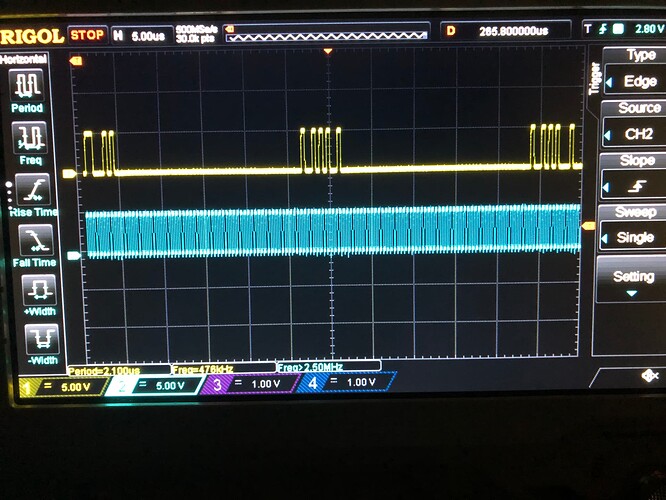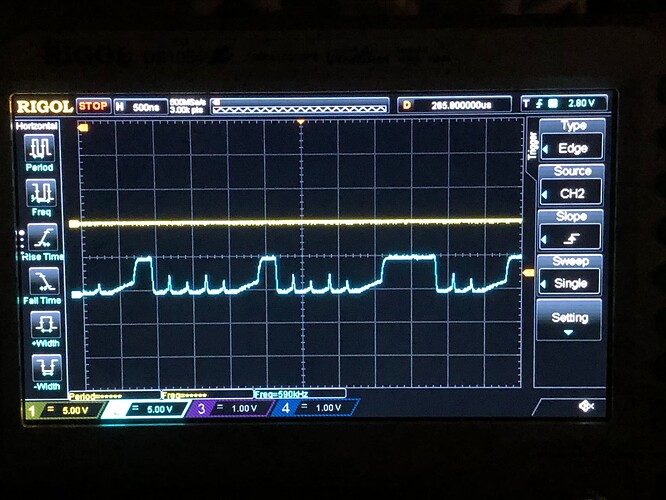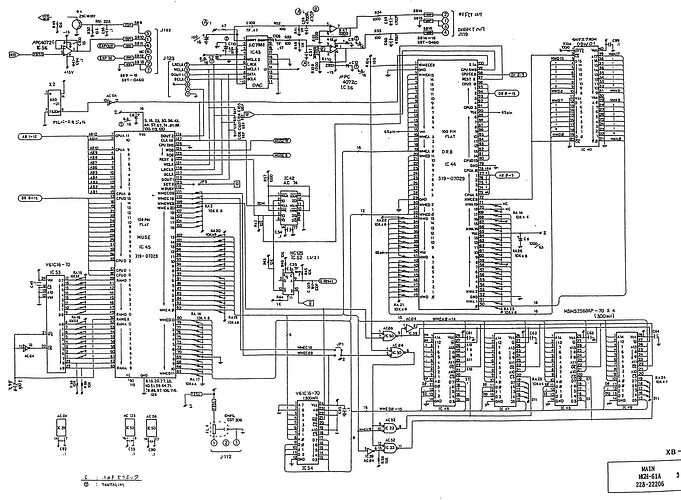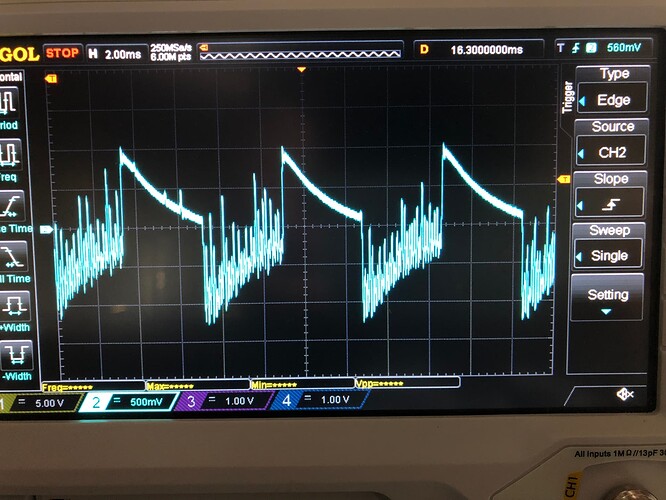I have a one-owner Hammond XB-2 organ - the first of their digitals. Its problem is “odd output” - definitely not Hammond-like. I have a copy of the service manual with schematic and I’ve been trying to run the problem down. I’ve seen in several places on the Internet that the MUSE and DRB chips on the main board - the ones that are actually computing the audio - are bespoke to the XB-2 and they often fail; there are no replacements other than working pulls.
I’m hoping that’s not the case here and I’m therefore trying to rule everything else out. I’ve been poking around with a scope but not coming up with anything yet, so I hoped if I described its symptoms maybe someone could give me insights.
I’ve done the factory reset and replaced the internal battery, which was down from 3V to about 1.5V. When you press a key, what comes out sounds square-wavy with some spiky distortion blended in. I’ve confirmed that it’s coming out of the DAC on the main board like and everything downstream of that (including vibrato/chorus and leslie effects) seems to work. The CPU is getting good drawbar input and displaying the drawbar positions on the LCD display, but they have absolutely no effect on the sound. Polyphony works (although the sound is even more horrid). Turning on percussion does appear to add something to the note attack. All of the pushbutton controls work as expected. But the most specific thing it’s doing is that the octave from middle C on the keyboard upward is a repeat of the octave below and so is every octave up from there all the way to the far right of the keyboard. I feel like that’s got to be a clue of some sort but I have no idea what.
its almost certainly the electrolytic capacitors have time expired. Simply replace them.
If there are any tantalum caps replace them too with new electrolytic.
Here’s why I’m not suspecting electrolytic or tantalum caps. First, tantalum caps generally fail catastrophically and that hasn’t happened. I checked the power supply first thing when I opened it up and whereas the +5V rail was down to +4.8V, I adjusted it via trimpot back up to 5.0V and it didn’t make any difference. I also checked the +5V rail for ripple and found none. That was also true of the +15V and -15V rails.
There does seem to be a 1000uF electrolytic between Vcc and ground near a handful of pins on the DRB chip but like I was saying, if that had problems bad enough to do this it should be visibly damaged and affecting the whole bus.
I’m not saying the electrolytics and tantalums shouldn’t be replaced for reliability’s sake but I really have trouble accepting them as the cause of the symptom I described. In fact, if I shotgun-replaced every one of those caps on the main board and found no joy I will have thrown good time and money after bad.
One thing I have thought to do is to go through all the various data and address busses looking for stuck bits. The final D/A conversion is fed by a single serial data line coming right out of the MUSE chip. I can perhaps try to scope that and see if the C keys that repeat are in fact sending the same pattern to the D/A; if not, then the D/A could be the problem.
Yes Tantalum caps explode in flames, but they can also internally fail leaving no exterior or visible trace. That’s why they’re so hated.
The bus can be checked with a logic probe, you don’t need a scope, but if you have one all your looking for is signs of operation. So long as all cpu bus pins are operating its not likely a bus issue.
If it is, as you suspect those chips in question, then all you can do is find another to salvage from.
You can also try asking at MUSE if they have or know of extra chips around.
https://www.nisshinbo-microdevices.co.jp/en/MUSES/
good luck
I have been poking around the Hammond XB-2 main board with schematic in hand trying to simultaneously figure out how it works and see if I can make any determinations about what is and is not working.
I spent some time on the DAC, which is a common LC7881. I’ve been able to see the serial bit stream going into it but I don’t have a remotely easy way to decode them; if I could show that each C from middle C up created the same bit stream then I would know for sure that the DAC isn’t the problem; ultimately, though, I have to conclude that that is the case anyway simply because the drawbars have no effect. There can’t be any internal flaws in the DAC that explain that. However, one thing that is strange is that the LC7881 is a 16-bit DAC and yet the number of active bits going into the DAC from the MUSE chip looks like maybe 11 or 12 (yellow trace - BTW there are single-trigger snapshots that I’m uploading here):
The mainboard schematic is three pages but here’s the one that shows the MUSE and DRB chips. There is a ROM chip that has 18 address lines and 16 data lines that services the DRB chip; I suspect it’s some sort of wavetable ROM in part because the lower several bits of address lines are performing a binary count; the upper bits are doing a more inscrutable dance. There may be several tonewheel recordings being used and there are also key click and key percussion sounds in play so it wouldn’t surprise me if it’s jumping around from wavetable to wavetable. In any case, whereas the address line signals look just like I’d expect, what’s coming out of the ROM chip’s data lines looks diseased (blue trace):
There’s nothing going on between the ROM and the DRB chips but board traces and a pair of pull-up resistor arrays so if I’m right that these ROM data signals are pathological, it’s got to be either the ROM or the DRB chips or perhaps the common end of one or both of those resistor arrays has somehow come unmoored from Vcc.
Any ideas?
Sorry, here’s the schematic page I meant to include:
Just to update, I ran the Hammond’s MIDI output into the MIDI Monitor app on macOS and was able to determine that the repeating-middle-octave thing was not reflected in the MIDI output; you’ll get C4, C5, C6…if you press those keys. Speaking of which, this is a single-trace of what comes out of the audio if you press C4:
The “spikies” are always in motion but the distorted squarewave shape remains constant. As I’m sure you folks realize, Hammond output is a sum of up to nine quasi-sinusoidal overtones; it shouldn’t look like this at
all. I am just about at the end of my rope here; the inscrutable MUSE and DRB chips and the associated mask ROM are basically unobtainium and the first two of those as well as the microcontroller are SMD flatpacks. The audio output seems like it’s loaded with clues as to what’s wrong but working backward from that to the mainboard’s operation is about to stump me. The behavior of the buttons, button LEDs, the two-row LCD display, and the MIDI output are all like nothing is wrong. Drawbar movement shows up in the LCD display; the pitch and mod wheels work but there’s just this weird audio. Oh there was something strange I noticed in the MIDI Monitor app: even with OMNI off, it’s sending on three channels: set output to channel 1 and you get note output in channels 1, 3, and 4. Set output to channel 16 and you get note output in channels 16, 3, and 4. I know Rev. 2 ROM (which this one has - that’s a story unto itself) had enhanced split-keyboard features but with this thing having one foot in the grave I’m unlikely to put much brain into trying to figure out why it acts like this.
Hello! I wanted to check on this old thread to see if you had luck resolving this problem? I’m experiencing the same thing with an XB-2 brought it for repair recently. First, it wouldn’t boot up at all. I found a bad capacitor in the 5V section. After replacing, everything powers up and works great, except the audio is distorted. I suspected one of the two DACs (LC7881C). Since they’re cheap, I replaced both of them, as well as the 1000uF caps in those sections. Still distorted. I tried injecting a sine wave way back into the audio path, and I don’t hear the distortion on the output. I’m suspecting the MUSE or DRB, from what all I’ve read. Everything else functions fine.. the Leslie effect, vibrato, percussion, etc are all there. Physical drawbar settings are accurately reflected on the LCD. Just each footage sounds distorted and crunchy, especially at certain settings. I don’t think the owner wants to put too much money in it, but I just want to make sure I’m not missing anything! Thanks
About the only thing more you can do is see if any of the DAC input bits are stuck high or stuck low. If not, then the problem is almost certainly the MUSE/DRB combination and IMO that XB-2 is done unless you have a donor - and even the donor part’s days are likely numbered. I hate that it’s like this and wish Hammond could or would adapt its existing production internals to make it possible to perform a swap. I pulled a few parts from mine for potential parts salvage or resale (I did sell the keyboard) and dumpstered the rest.
Thanks so much! I just checked those inputs, and I do see data. Though one pin only showed data on key press, which I assume is normal. I also applied a sine wave right at the DAC’s outputs, and heard no distortion on the main output. I already told the customer the bad news. RIP XB-2 
Hello, I have just purchased an old Hammond XB2. It was not working.
I took all the PCB boards out cleaned all the connectors. None of the Capacitors looked blown. I think power is flowing across all the boards.
I restored the keyboard, new rubbers etc.
Now when I power on, the Green Led Screen lights up but no title text. Just a little blank green screen. None of the white buttons on the left light up when pressed. The Key Press Red LED on one of the PCB boards is perminantly on.
If I switch the power on and off several times (probably 10 times) then eventually, I do get the switch on text on the LED Green screen, the white buttons do light up and work. All the draw bars function. The LED on the PCB board goes out until I press a keyboard note. I have sound and can play but the sound is incredibly crackley. I have moved the amp plug to other outputs with the same result.
I am not very electrically knowledgeable but am willing to have a crack at soldering new components in.
Any clue what I should do next. Thank you
Rachel
Sounds like there was more than one problem but the one that’s really worrisome is that “incredibly crackley” sound. Many if not most/all XB-2s eventually develop a problem with their “MUSE” and “DRB” ICs that actually do the tone generation for the instrument. They are custom to the XB-2, are out of production, and will almost certainly never be in production again. Sourcing them as recovered parts is inherently difficult. On the one I attempted to repair, everything else worked perfectly - the drawbars, the effects, the display, the buttons. Moving the drawbars would show up on the display and I was even able to see a multiplexed “readout” of the drawbar positions on an oscilloscope hooked up to the right place but they had no effect on the sound. It’s difficult to describe what comes out of the output; it’s kind of a “croak” or “rasp;” I’d know it if I heard it. Sad to say that your XB-2 is probably scrap. There are so many hardware and software alternatives that really, I’m not sure it’s worth beating one’s head against a wall over it.
1 Like
Thank you for responding.
That is sad news. I think for fun, I will try to deal with the starting problem, (e.g. 10 attempts to get the organ to start). So I guess I can check the Capacitors properly instead of visually.
If it starts correctly that could be the same cause as the crackling. However, if it isn’t, I fear you will be correct. There are a few boards on eBay, I could try getting one of them, but realise they could have the same faults.
I appreciate you coming back to me.
Rachel



